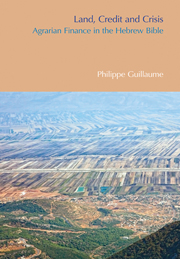Book contents
- Frontmatter
- Contents
- Illustrations
- Acknowledgements
- Introduction
- Part I Land
- 1 Land Tenure
- 2 Communal Land
- 3 The Myth of the Helpless Peasant
- 4 New Perspectives on Land Passages
- Part II Credit
- Part III No Crisis in Yehud
- General Conclusion
- Glossary
- Bibliography
- Index of Biblical References
- Index of Authors
- Index of Subjects
4 - New Perspectives on Land Passages
from Part I - Land
- Frontmatter
- Contents
- Illustrations
- Acknowledgements
- Introduction
- Part I Land
- 1 Land Tenure
- 2 Communal Land
- 3 The Myth of the Helpless Peasant
- 4 New Perspectives on Land Passages
- Part II Credit
- Part III No Crisis in Yehud
- General Conclusion
- Glossary
- Bibliography
- Index of Biblical References
- Index of Authors
- Index of Subjects
Summary
Thanks to the recovery of the importance of communal tenure systems and of strategies farmers used to cope with natural and social risks, a fresh look can be cast at a selection of biblical passages relative to land.
Poor Naboth (1 Kgs 21)
The story of the appropriation of Naboth's vineyard by criminal means is one of the pillars of biblical latifundialism (1 Kgs 21:1–19). Albrecht Alt (1959) saw Ahab's offer as evidence for the rise of a ‘Canaanite’ commodification/mercantilization of land tenure that was at loggerheads with the ‘Israelite’ Bodenrecht. Alt took Shemer's sale of the Samaria hill to Omri (1 Kgs 16:24) as an illustration of Canaanite land laws that allowed the sale of land, whereas Naboth's refusal to sell his vineyard to Ahab proved that in the Israelite conception land was inalienable. The Canaanite right was later considered as proto-capitalist in opposition to the Israelite concept that then could legitimize any anti-capitalist ideology (Bohlen 1978: 349).
David's purchase of a threshing floor from Araunah (2 Sam. 24:24) challenges the notion of an Israelite land law distinct from its Canaanite counterpart and exegetes spent treasures of ingenuity in exonerating David from his Canaanite behaviour (Ben-Barak 1981). The Islamic tenure system shows that inalienable tenure and alienable freehold property can co-exist within one system and that the Canaanite versus Israelite opposition reflects the ideology of prophetic texts rather than ancient reality.
Nevertheless, the story of Naboth's vineyard is presented as evidence for the existence of a land market in Israel and of prophetic resistance to it (Silver 1983: 74; Brueggemann 1993: 209).
- Type
- Chapter
- Information
- Land, Credit and CrisisAgrarian Finance in the Hebrew Bible, pp. 67 - 108Publisher: Acumen PublishingPrint publication year: 2012



